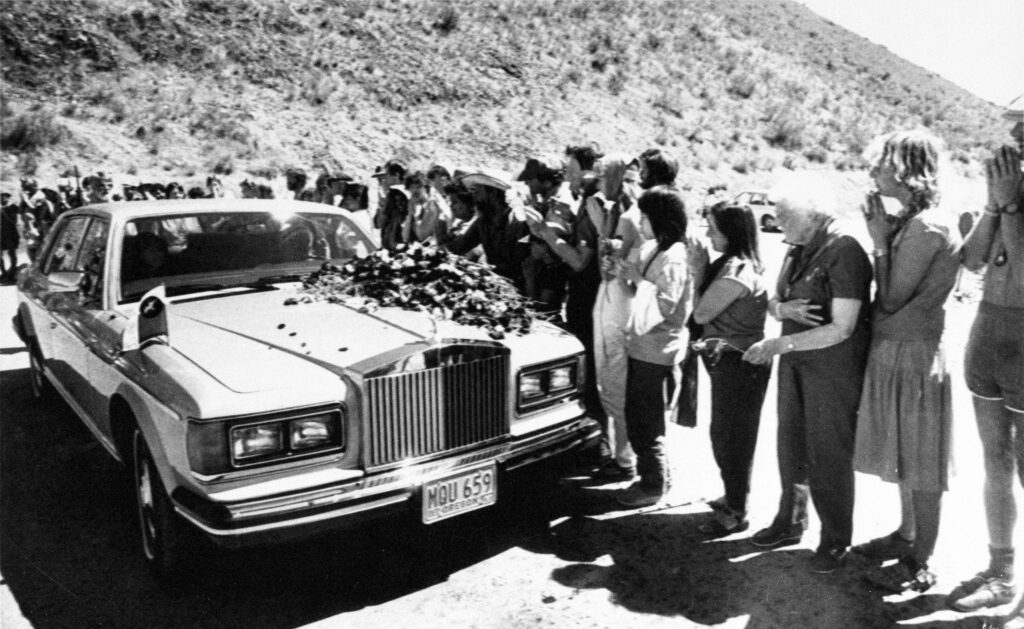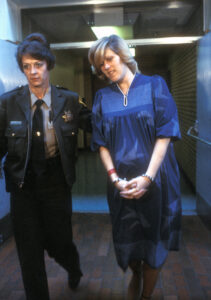The volcano, the Bhagwan, a morning paper

1977-1987
Mount St. Helen’s finally blew on May 18, 1980 – The Register-Guard’s journeyman photographer, Wayne Eastburn, capturing the bulging volcano’s spectacular force from just 30 miles away.
Oregonians were starting to get used to the idea that an Indian guru named Bhagwan Shree Rajneesh might actually create his own town and way of life in Wasco County.

The Hult Center for the Performing Arts opened in 1982 right about where John Brown Alexander started The Guard 115 years earlier.
And during all of this excitement, two significant things happened for the newspaper.
It changed to morning delivery in 1983, and the third generation of the Baker family – the 16 grandchildren of Alton Sr. and Mildred Baker – convinced their parents in 1987 that they were committed to owning and operating The Register-Guard into the 21st century.
That a fictional “shaggy haired stranger” would emerge in the middle of it all just reminded everyone that there is evil in the world and that one of journalism’s roles is to march it out into the light of day.
The paper was still called the Eugene Register-Guard, and it was still an afternoon paper on weekdays – had been for 116 years – on May 20, 1983, when the headline “Gunman shoots children, mother,” sat atop the front page.

But there was no “gunman,” just a very troubled Elizabeth Diane Downs, 27. Prosecutors would show that Downs had shot to death her 7-year-old daughter, Christie, and severely wounded Cheryl, 8, and Danny, 3, the latter left paralyzed, before shooting herself in the arm on the night of May 19, 1983, on a lonely stretch of Old Mohawk Road north of Springfield.
Downs, a Springfield woman who worked as a postal carrier in Cottage Grove, was convicted of murder in 1984 and sentenced to life in prison plus 50 years. She has always maintained that a man with “shaggy brown hair” shot her and her children.
If the Carl Bowles’ saga of 1974 had everything for a made-for-TV movie, the Downs’ saga actually became, in 1989, a made-for-TV movie, starring Farrah Fawcett as Downs. It was based on the best-selling book, “Small Sacrifices,” by Seattle true-crime author Ann Rule.
The changeover to morning publication in 1983 – a decision made by Ted Baker, the Register-Guard’s longtime general manager who, in 1982, had replaced older brother Bunky Baker as publisher – was driven by a growing national newspaper trend, reflective of a changing marketplace as well as lifestyles among readers.
The Eugene Register-Guard also became The Register-Guard on Sept. 12, 1983, to reflect its growth over the years into a regional newspaper with coverage that extends beyond Eugene.

“It was the right thing to do, because at night the City Council usually met and we had fresh information for the paper in the morning,” says Ted Baker, about the change to morning delivery, seven days a week.
“We had stock market (information) at the time. It seemed like a good idea to have that information available (in the morning) to the public, so they could work with it all day long.
“The other thing was the kids, who got up in the morning and then had their whole afternoon, after school, open to do what they wanted to do, whether it was sports or something else.
“So, those were three things that I felt were important. And we took a very short time, about three months, to swing the paper over to mornings. And we did it quick because it was important to move quickly. I think we gained 2,000 or 3,000 subscribers.”
Company circulation figures show that the paper actually lost subscribers, initially, dropping from 65,552 average daily circulation at the end of 1982, to 64,941 in 1983, after the conversion. But new subscribers did come around within a couple of years, climbing to 67,049 in 1984 and 69,287, with 72,733 on Sundays, in 1985.
As for the “junior dealers,” which is what The Register-Guard called its under-18 newspaper carriers at the time, many quit their routes over the conversion, not wanting to get out of bed before the crack of dawn on weekdays (as they were already doing on weekends) to meet the new 6:30 a.m. delivery deadline promised to subscribers.
About 160 out of 963 carriers at the time quit their routes in late summer 1983, according to the paper’s special section on Sept. 12, 1983, about the changeover. But the paper had received more than 150 applications from prospective carriers, many of them adults looking for work during the early ’80s recession that hit Lane County.
The change to morning delivery was also a shakeup for Register-Guard employees, especially the pressmen who now had to work graveyard shifts.
“I think it stinks,” pressman Earl Schulze said in the special section. “If they could prove to me they’re going to make a lot more money, fine. But I can’t see it, and it just screws up your whole life cycle.”
But everyone lived, and The Register-Guard did indeed prosper from the change, as the 1990s would show.
Mark Baker, who researched and wrote the stories for this special section, is a former Register-Guard reporter and a member of the third generation of the Baker family.

Mark Baker has been a journalist for the past 25 years. He’s currently the sports editor at The Jackson Hole News & Guide in Jackson, Wyo.
